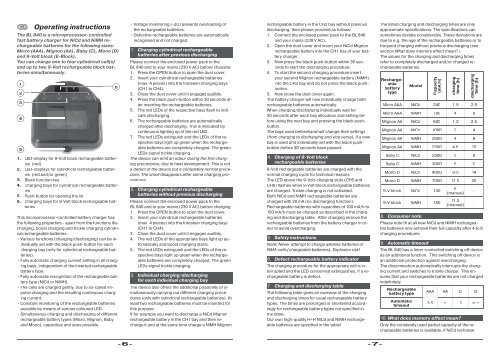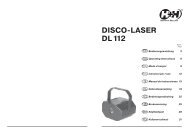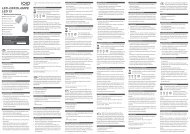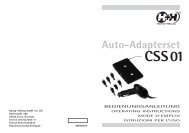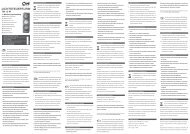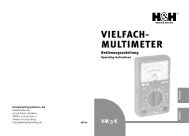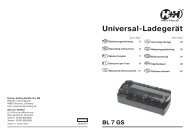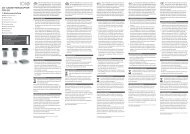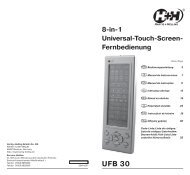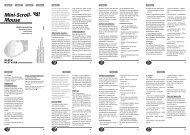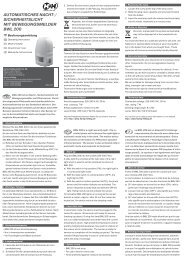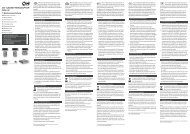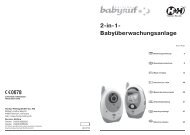UNIVERSAL-LADEGERÄT BL 840 - Hartig + Helling GmbH & Co. KG
UNIVERSAL-LADEGERÄT BL 840 - Hartig + Helling GmbH & Co. KG
UNIVERSAL-LADEGERÄT BL 840 - Hartig + Helling GmbH & Co. KG
You also want an ePaper? Increase the reach of your titles
YUMPU automatically turns print PDFs into web optimized ePapers that Google loves.
Operating instructions<br />
The <strong>BL</strong> <strong>840</strong> is a microprocessor-controlled<br />
fast battery charger for NiCd and NiMH rechargeable<br />
batteries for the following sizes:<br />
Micro (AAA), Mignon (AA), Baby (C), Mono (D)<br />
and 9-Volt block (E-Block).<br />
You can charge one to four cylindrical cell(s)<br />
and up to two 9-Volt rechargeable block batteries<br />
simultaneously.<br />
1<br />
2<br />
3<br />
4<br />
5<br />
1. LED-display for 9-Volt block rechargeable batteries<br />
(red)<br />
2. LED-displays for cylindrical rechargeable batteries<br />
(red and/or green)<br />
3. Black function key<br />
4. Charging bays for cylindrical rechargeable batteries<br />
5. Push-button for opening the lid<br />
6. Charging bays for 9-Volt block rechargeable batteries<br />
This microprocessor-controlled battery charger has<br />
the following properties - apart from the functions discharging,<br />
boost charging and trickle charging cylindrical<br />
rechargeable batteries:<br />
• Various functions (charging/discharging) can be individually<br />
set with the black push-button for each<br />
charging bay (only for cylindrical rechargeable batteries).<br />
• Fully automatic charging current setting in all charging<br />
bays, independent of the inserted rechargeable<br />
battery type.<br />
• Fully automatic recognition of the rechargeable battery<br />
type (NiCd or NiMH).<br />
• The cells are charged gently, due to so-called impulse<br />
charging and the resulting continuous charging<br />
current.<br />
• <strong>Co</strong>nstant monitoring of the rechargeable batteries<br />
possible by means of various coloured LED.<br />
• Simultaneous charging and discharging of different<br />
rechargeable battery types (Micro, Mignon, Baby<br />
and Mono), capacities and sizes possible.<br />
6<br />
• Voltage monitoring (-∆U) prevents overloading of<br />
the rechargeable batteries.<br />
• Defective rechargeable batteries are automatically<br />
recognised and not charged.<br />
1. Charging cylindrical rechargeable<br />
batteries after previous discharging<br />
Please connect the enclosed power pack to the<br />
<strong>BL</strong> <strong>840</strong> and to your mains (230 V AC) before charging.<br />
1. Press the OPEN button to open the dust cover.<br />
2. Insert your cylindrical rechargeable batteries<br />
(max. 4 pieces) into the foreseen charging bays<br />
(CH1 to CH4).<br />
3. Close the dust cover until it engages audibly.<br />
4. Press the black push-button within 30 seconds after<br />
inserting the rechargeable batteries.<br />
5. The red LEDs of the respective bays flash to indicate<br />
discharging.<br />
6. The rechargeable batteries are automatically<br />
charged after discharging. This is indicated by<br />
continuous lighting up of the red LED .<br />
7. The red LEDs extinguish and the LEDs of the respective<br />
bays light up green when the rechargeable<br />
batteries are completely charged. The green<br />
LEDs signal trickle charging.<br />
The device can emit an odour during the first charging<br />
procedures, due to heat development. This is not<br />
a defect of the device but a completely normal procedure.<br />
The smell disappears after some charging procedures.<br />
2. Charging cylindrical rechargeable<br />
batteries without previous discharging<br />
Please connect the enclosed power pack to the<br />
<strong>BL</strong> <strong>840</strong> and to your mains (230 V AC) before charging.<br />
1. Press the OPEN button to open the dust cover.<br />
2. Insert your cylindrical rechargeable batteries<br />
(max. 4 pieces) into the foreseen charging bays<br />
(CH1 to CH4).<br />
3. Close the dust cover until it engages audibly.<br />
4. The red LEDs of the appropriate bays light up automatically<br />
and boost charging starts.<br />
5. The red LEDs extinguish and the LEDs of the respective<br />
bays light up green when the rechargeable<br />
batteries are completely charged. The green<br />
LEDs signal trickle charging.<br />
3. Individual charging/discharging<br />
for each individual charging bay<br />
The device also offers the additional possibility of simultaneously<br />
carrying out different charging procedures<br />
(only with cylindrical rechargeable batteries). At<br />
least two rechargeable batteries must be inserted for<br />
this purpose.<br />
If for example you want to discharge a NiCd Mignon<br />
rechargeable battery in the CH1 bay and then recharge<br />
it and at the same time charge a NiMH Mignon<br />
rechargeable battery in the CH2 bay without previous<br />
discharging, then please proceed as follows:<br />
1. <strong>Co</strong>nnect the enclosed power pack to the <strong>BL</strong> <strong>840</strong><br />
and your mains (230 V AC).<br />
2. Open the dust cover and insert your NiCd Mignon<br />
rechargeable battery into the CH1 bay of your battery<br />
charger.<br />
3. Now press the black push-button within 30 seconds<br />
to start the discharging procedure.<br />
4. To start the second charging procedure insert<br />
your second Mignon rechargeable battery (NiMH)<br />
into the CH2 bay and do not press the black pushbutton.<br />
5. Now close the dust cover again.<br />
The battery charger will now individually charge both<br />
rechargeable batteries automatically.<br />
When charging/discharging individually wait for<br />
30 seconds after each bay allocation and setting before<br />
using the next bay and pressing the black pushbutton.<br />
The bays used beforehand will change their settings<br />
(from charging to discharging and vice versa), if a new<br />
bay is used and individually set with the black pushbutton<br />
before 30 seconds have passed.<br />
4. Charging of 9-Volt block<br />
rechargeable batteries<br />
9-Volt rechargeable batteries are charged with the<br />
normal charging cycle for technical reasons.<br />
The LED above the 9-Volt-charging slots (CH5 and<br />
CH6) flashes when 9-Volt block rechargeable batteries<br />
are charged. Trickle charging is not activated.<br />
Both NiCd and NiMH rechargeable batteries are<br />
charged with 20 mA (no discharging function).<br />
Rechargeable batteries with capacities of 100 mA/h to<br />
150 mA/h must be charged as described in the charging<br />
and discharging table. After charging remove the<br />
rechargeable batteries from the battery charger in order<br />
to avoid overcharging.<br />
5. Safety instructions<br />
Note! Never attempt to charge alkaline batteries or<br />
RAM-cells (chargeable batteries). Explosion risk!<br />
6. Defect rechargeable battery indicator<br />
The charging procedure for the appropriate cell is interrupted<br />
and the LED concerned extinguishes, if a rechargeable<br />
battery is defect.<br />
7. Charging and discharging table<br />
The following table gives an overview of the charging<br />
and discharging times for usual rechargeable battery<br />
types. The times are prolonged or shortened accordingly<br />
for rechargeable battery types not specified in<br />
the table.<br />
Our own high-quality H+H NiCd and NiMH rechargeable<br />
batteries are specified in the table!<br />
The listed charging and discharging times are only<br />
approximate specifications. The specifications can<br />
sometimes deviate considerably. These deviations are<br />
due to e.g. the age of the rechargeable batteries or to<br />
frequent charging without previous discharging (see<br />
section What does memory effect mean?).<br />
The values for the charging and discharging times<br />
refer to completely discharged and/or charged rechargeable<br />
batteries.<br />
Rechargeable<br />
battery<br />
type<br />
Model<br />
Capacity<br />
(mA/h)<br />
charging<br />
time (h)<br />
discharging<br />
time (h)<br />
Micro AAA NiCd 240 1.5 2.5<br />
Micro AAA NiMH 700 4 8<br />
Mignon AA NiCd 600 1.2 2.5<br />
Mignon AA NiCd 1000 2 4<br />
Mignon AA NiMH 2000 4 9<br />
Mignon AA NiMH 2300 4.6 12<br />
Baby C NiCd 2500 5 9<br />
Baby C NiMH 3000 6 11<br />
Mono D NiCd 4000 9.5 14<br />
Mono D NiMH 7000 11.5 20<br />
9-V block NiCd 100<br />
9-V block NiMH 150<br />
6<br />
(manual)<br />
11.5<br />
(manual)<br />
8. <strong>Co</strong>nsumer note<br />
Please note th at all new NiCd and NiMH rechargeable<br />
batteries only achieve their full capacity after 4 to 6<br />
charging procedures.<br />
9. Automatic timeout<br />
The <strong>BL</strong> <strong>840</strong> has a timer-controlled switching off device<br />
as an additional function. This switching off device is<br />
an additional protection against overcharging.<br />
The disconnection automatically interrupts the charging<br />
current and switches to trickle charge. This ensures<br />
that your rechargeable batteries are not charged<br />
indefinitely.<br />
Rechargeable<br />
battery type<br />
AAA AA C D<br />
Automatic<br />
timeout<br />
3.5 5 6 11.5<br />
10. What does memory effect mean?<br />
Only the constantly used partial capacity of the rechargeable<br />
batteries is available, if NiCd recharge-<br />
-<br />
-<br />
-6- -7-


